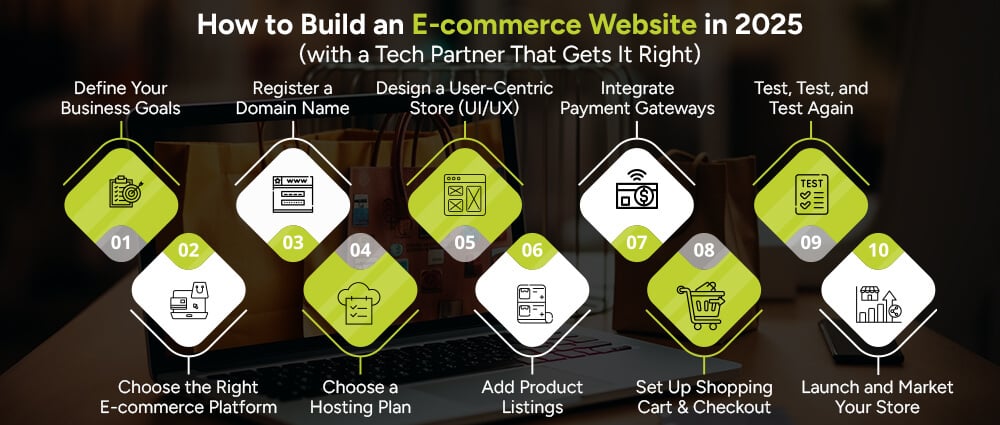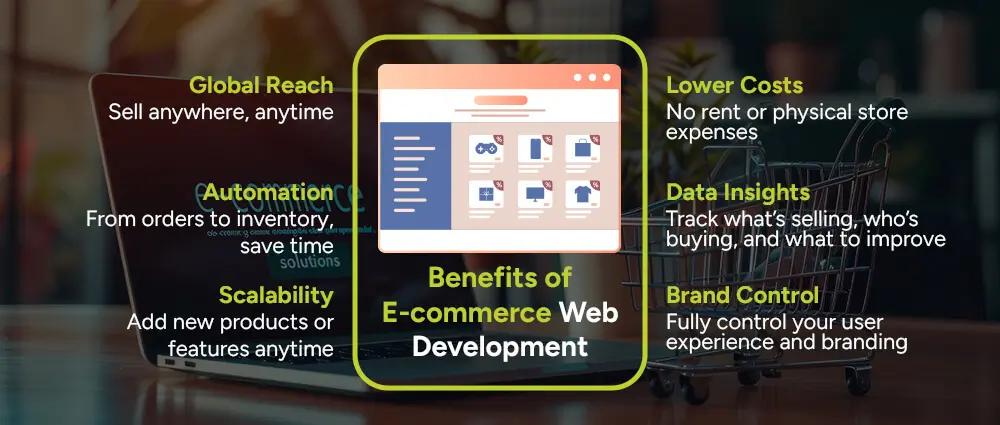Online shopping isn’t just a trend anymore; it’s a lifestyle. In 2025, more people will choose to shop online than ever before. Whether it’s groceries, fashion, electronics, or even cars, everything is now just a few clicks away. That’s where E-commerce Web Development comes into play.
In this complete guide, we’ll walk you through everything you need to know, from understanding what e-commerce web development is to building your own online store. So, are you ready? Let’s dive in.
E-commerce Web Development is basically the act of creating and taking care of a site that sells things. Everything from making the website’s look and feel to implementing payment gateways for collecting money, product catalogs, user dashboards, order tracking-and more. It is about developing a user-friendly and safe online shopping experience for customers, whether 10 products or 10,000.

Developing an e-commerce site can be quite daunting, but management becomes easier and mostly successful if the route is laid down well and the right development teams are in your corner. Our focus today is on how to develop an effective e-commerce site in 2025, whether you are a startup, a growing business, or an enterprise retailer. Here, you can get insights from a professional software development perspective.
Every successful e-commerce project starts with a vision.
A software development company always begins every engagement by aligning on these foundational goals. We collaborate with you to understand your unique value proposition, which shapes both the technical architecture and user experience of your site.
The selection of the right kind of foundation would entail consideration of off-the-shelf platforms like Shopify, WooCommerce, and Magento, or fully customized solutions. This way, a software development company can help you evaluate the best-fit E-commerce website builder option based on your business model, need for scalability, integration requirements, or budget, so never hesitate to reach out for help.
Your domain name is your online storefront. Companies also help clients brainstorm brandable, SEO-friendly names and register them securely. Need domain redirection or multi-region URLs? development companies can help you get the best mobile e-commerce sites.
Performance starts with strong infrastructure. Our team ensures that your e-commerce site is backed by robust, scalable hosting.
Options include:
We also implement CDNs, caching strategies, and auto-scaling to keep your store lightning fast.
Great e-commerce design isn’t just about looks, it’s about conversions.
Our UI/UX team crafts visually compelling, mobile-responsive storefronts that are:
From wireframes to high-fidelity prototypes, our design process ensures a smooth shopping experience for your customers.
We help structure your product catalog for scalability and searchability. This includes:
Our CMS integration and admin dashboard make managing listings effortless for your team.
Seamless and secure payments build trust. Our developers integrate:
All implementations follow the latest PCI DSS standards and include SSL certificates for full-site encryption.
A complicated checkout = lost sales. In 2025, one-page, frictionless checkouts are a must. We design checkout flows that are:
Before launch, we run rigorous QA and performance tests, including:
Our goal: a bug-free, fast, and secure launch.
Once everything’s perfect, it’s time to go live. But it doesn’t stop there.
Our digital team supports your post-launch success through:
Are you ready to launch your latest website and display your products to your audience?
The cost depends on several factors like design, features, platform, and whether you use a freelancer, an in-house team, or an e-commerce website development agency.
Here’s a quick breakdown:
Tip: Start small and scale as you grow.
Your online store should be more than just “pretty.” It needs to work well. Here are key functionalities to consider:
A good e-commerce web development service will help you include these smart functions and trends in the e-commerce industry in your business.
Want your online store to actually convert visitors, not just look pretty? In the fast-moving world of e-commerce, it takes more than a sleek design to stay competitive. Here are some tried-and-tested tips to make your e-commerce website shine in 2025.
The bottom line: Slow site speed hurts business. In the case of your store, if it takes more than 3 seconds for the webpage to load, the chances are that you are losing potential buyers even before they see your products.
Faster-loading pages ensure better user experience, higher search ranking results, and increased conversion rates. Our development team has employed techniques like image compression, efficient coding, caching strategies, and scalable cloud hosting to make sure that performance is never an impediment to a sale.
Your product photos are your digital storefront. Poor-quality images don’t just look bad, they reduce trust and lower conversion rates.
High-quality visuals create confidence. Show your products from multiple angles, use clean backgrounds, and include lifestyle shots when possible. If your products have unique textures, finishes, or features, highlight them with close-ups or even videos. Strong visuals reduce returns, build brand credibility, and help customers buy with confidence.
Good product descriptions do more than describe; they sell. Avoid vague, generic copy and get straight to the point. What is the product? Who is it for? What problem does it solve?
Make your descriptions clear, concise, and benefit-focused. Talk like your ideal customer, not like a spec sheet. Don’t just say “durable”, say “built to last through daily use without losing shape.” Pair it with bullet points, formatting, and naturally included keywords for better readability and SEO.
Online customers can’t see you in person, so you have to earn their trust quickly. Add credibility by displaying elements like SSL certificates, security badges, verified payment methods, and refund or return guarantees.
Even better? Use testimonials and product reviews to let past customers do the talking. A strong return policy and clear shipping info reduce buyer hesitation. Trust signals aren’t optional in 2025, they’re essential.
Mobile traffic continues to dominate online shopping, over 70% of users browse and buy from their phones. If your site isn’t designed with a mobile-first mindset, you’re risking lost sales.
Think clean navigation, thumb-friendly buttons, fast loading times, and seamless mobile checkout experiences. Our development approach ensures responsive design from day one, so your store performs flawlessly on all screen sizes.
What’s great about your store if no one really knows about it. Enter search engine optimization into the picture! SEO is what allows your website to show up on search results when someone types in what you are selling.
Development houses will guide one to structure content and metadata correctly: titles loaded with keywords, optimized image tags, clean URLs, and well-thought-out internal linking. To further increase online visibility, we advise a blogging strategy targeting long-tail keywords that answer common customer questions.
Having a site that gets updated often is definitely recommended.
Nothing signals an inactive brand more than a website with outdated products or old promotions. A modern e-commerce store should evolve constantly, whether that’s updating inventory, changing homepage banners, rotating seasonal offers, or publishing fresh blog content.
Many development companies build content management systems that make it easy for non-technical teams to update product listings, blog posts, and even navigation menus. Staying current keeps your store engaging for return visitors and tells search engines your site is alive and active.
Why invest in e-commerce web development? Here’s what you get:

A custom e-commerce web development solution gives you full control and scalability. You can tailor the site to match your unique business needs, integrate third-party APIs, and build features your competitors don’t have. If you’re planning to grow big, custom is the way to go.
Not tech-savvy or just short on time? Hiring an experienced e-commerce website development agency can save you a lot of stress. They’ll handle everything from design to launch and even offer support afterward.
Whether you’re starting a small boutique or launching the next Amazon, ecommerce web design and development is your gateway to success. With the right planning, tools, and expert help, your online store can thrive in 2025 and beyond.
Need a team to help you get started? Consider working with Arpatech, a professional eCommerce development company that understands your vision and can turn it into reality.
To build from scratch:
You can do this solo or with help from an e-commerce web development service.
E-commerce in 2025 is all about:
If you’re building an online store, you’re entering a booming space with huge potential.